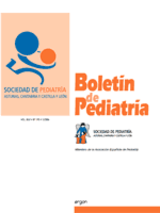Epidemiología de la infección estreptocócica faríngea en un área de salud
C. Ochoa Sangrador , Mª.F. Brezmes Valdivieso , L. López-Urrutia Lorente , Mª.N. Gutiérrez Zufiaurrez , Mª. V. Barajas Sánchez , A. Fe Bajo Delgado
Bol. Pediatr. 2006; 46 (195): 32 - 38
Objetivos: describir la evolución de la infección faríngea por Streptococcus pyogenes en un área de salud. Valorar el riesgo en función de la edad y época del año, así como la tendencia de la resistencia a antimicrobianos. Material y métodos: estudio descriptivo de 4.773 cultivos faríngeos procedentes de pacientes pediátricos (< 15 años) procesados desde enero de 1995 hasta septiembre de 2005 en el laboratorio de Microbiología del Hospital Virgen de la Concha, de Zamora. Comparación del porcentaje de aislamientos de S. pyogenes por grupos de edad y mes del año en 745 muestras procedentes de atención primaria en los 2 últimos años. Análisis de la tendencia de resistencia a penicilina, eritromicina y clindamicina de todos los aislamientos. Resultados: analizamos 4.773 cultivos faríngeos en los que se aislaron 791 cepas de S. pyogenes (16,5%). De los 745 cultivos procedentes de primaria (media de edad: 5,8 años) desde julio de 2003, se aisló S. pyogenes en 158 muestras (21,2%; IC 95%: 18,2-24,2). El porcentaje de aislamientos para los menores de 3 años fue del 6,8% (menores de 2 años: 1,8%). No encontramos diferencias por meses. Ninguna cepa era resistente a penicilina, mientras que a eritromicina lo eran el 34,2% (IC 95%: 30,8-37,6) y a clindamicina el 5,09% (IC 95%: 3,4-6,7). En los últimos años hay una tendencia a la disminución de la resistencia a eritromicina (p = 0,042) y al aumento de la resistencia a clindamicina (p = 0,0013). Conclusiones: el aislamiento de S. pyogenes en cultivos faríngeos es poco frecuente, especialmente en menores de 3 años, por lo que en este grupo de edad el tratamiento antibiótico empírico no parece justificado en ausencia de confirmación microbiológica. Tenemos un alto porcentaje de resistencia a macrólidos de 14 y 15 átomos de carbono, aunque con tendencia a su recuperación; este alto porcentaje de resistencia sigue desaconsejando su uso empírico. Abstract Objectives: To describe the evolution of the pharyngeal infection by Streptococcus pyogenes in a health area. To value the risk based on the age and on the time of the year, as well as the tendency of antimicrobian resistance. Methods: descriptive study of 4,773 pharyngeal cultures belonging to pediatric patients (< 15 years), realized from January of 1995 to September of 2005 in the Laboratory of Microbiology of the Hospital Virgen de la Concha of Zamora. Comparison of the percentage of isolations of S. pyogenes by groups of age and month of the year in 745 samples received from primary health care setting in the last two years. Analysis of the tendency of resistance to penicillin, erythromycin and clindamycin of all the isolations. Results: in total, 4,773 pharyngeal cultures were analyzed, in which 791 strains of S. pyogenes were isolated (16.5%). Of the 745 cultures received from primary care (average age: 5.8 years) from July of 2003, S. pyogenes was isolated in 158 samples (21.2%; 95%CI: 18.2-24.2). The percentage of isolations for the younger than 3 years was 6.8% (younger than 2 years: 1.8%). We did not find differences per months. No strain was resistant to penicillin, whereas 34.2% (95%CI: 30.8-37.6) were to erythromycin and 5.09% (95%CI: 3.4-6.7) to clindamycin. In the last years there is a tendency to the diminution of the resistance to erythromycin (p = 0.042) and to the increase of the resistance to clindamycin (p = 0.0013). Conclusions: the isolation of S. pyogenes in pharyngeal cultures is little frequent, mainly in younger than 3 years, reason why in this group of age the empirical antibiotic treatment does not seem justifiable, in absence of microbiological confirmation. We have a high percentage of resistance to macrolides of 14 and 15 atoms of carbon, although with tendency to its recovery; this high percentage of resistance continues advising against its empirical use.
\N
\N
Artículo completo (PDF) (111 kb.)
- Infectología
